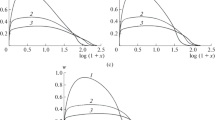Abstract
Based on the equations of the classical linear theory of elasticity, a model problem of the stress-strain state of an elastic cylinder simulating a meteoroid falling in the atmosphere with a thin surface layer heated due to thermal loads is formulated and analytically solved. The influence of an inhomogeneous temperature field on this process is isolated and separately investigated within the linear formulation of the problem. The maximum shear stresses are calculated for two cases of heating this layer, corresponding to a rapidly rotating cylinder and one moving without rotation, exceeding the critical value of the strength of its material. Over the past decade, astronomers have identified several dozen small decameter-sized bodies of the solar system, which have sufficiently high initial periods of rotation even in outer space. The features of the mechanisms of the formation of the surface relief of precipitating meteoroids of various types for these cases are revealed. Thus, rapidly rotating meteoroids, subject to the peeling effect—dropping off of a thin heated outer layer—fell out in the form of meteorites with a smooth surface structure. For those that fell progressively, the meteorites had a sculptural surface relief covered with regmaglypts generated by Görtler vortices.




Similar content being viewed by others
REFERENCES
E. F. F. Chladni, Über den Ursprung der von Pallas gefundenen und anderer ihr ähnlicher Eisenmassen, und über einige damit in Verbindung stehende Naturerscheinungen (Hartknoch, Riga, 1794).
E. L. Krinov, Fundamentals of Meteoritics (Gostekhizdat, Moscow, 1955) [in Russian].
A. N. Simonenko, Meteorites are Fragments of Asteroids (Nauka, Moscow, 1979) [in Russian].
Meteoritical Bulletin Database. http://www.lpi.usra.edu/meteor/metbull.php.
T. Nagata (ed.), Proceedings of the Second Symposium on Yamato Meteorites, Memoirs of National Institute of Polar Research, Special Issue, No. 8 (Natl. Inst. Polar Res., Tokyo, 1978).
D. W. Hughes, “Meteorite falls and finds: some statistics,” Meteoritics 16, 269–281 (1981).
“Spinning meteors,” Sky & Telescope 77 (1), 11–12 (1989).
V. A. Andrushchenko, A. N. Galenko, V.A. Goloveshkin, and N. N. Kholin, “The effect of rotation on the stress-strain state of a cosmic body moving in the atmosphere,” Kinemat. Phys. Celest. Bodies 23 (4), 172–184 (2007).
E. N. Slyuta, “Physical and mechanical properties of stony meteorites,” Solar Syst. Res. 51 (1), 64–85 (2017).
E. N. Slyuta, “Physicomechanical properties and gravitational deformation of metallic asteroids,” Solar Syst. Res. 47 (2), 109–126 (2013).
N. N. Kholin, V. A. Goloveshkin, and V. A. Andrushchenko, Mathematical Modeling of Wave Phenomena in Condensed Matter and Meteoroid Dynamics (URSS Lenand, Moscow, 2016) [in Russian].
E. Levitan, “Common and unusual asteroids,” Nauka Zhizn, No. 9, 93–96 (2008).
P. A. Polivanov, Yu. V. Gromyko, A. A. Sidorenko, and A. A. Maslov, “Turbulization of the wake behind a single roughness element on a blunted body at a hypersonic Mach number,” J. Appl. Mech. Tech. Phys. 58 (5), 845–852 (2017).
D. Aymer de la Chevalerie, A. Fontenean, L. de Luca, and G. Cardone, “Görtler-type vortices in hypersonic flows: the ramp problem,” Exp. Therm. Fluid Sci. 15 (2), 69–81 (1997).
A. V. Ivanov, Y. S. Kachanov, and D. A. Mischenko, “Generation of nonstationary Görtler vortices by localized surface nonuniformities. Receptivity coefficients,” Thermophys. Aeromech. 19 (4), 523–539 (2012).
H. Görtler, “On the three-dimensional instability of laminar boundary layers on concave walls,” Technical Memorandum 1375 (NACA, Washington, 1954) [translation of the original paper, Göttingen, 1940; in German].
A. L. Laganelli and D. E. Nestler, “Surface ablation patterns: A phenomenology study,” AIAA J. 7 (7), 1319–1325 (1969).
P. V. Chuvakhov, V. Ya. Borovoy, I. V. Egorov et al., “Effect of small bluntness on formation of Görtler vortices in a supersonic compression corner flow,” J. Appl. Mech. Tech. Phys. 58 (6), 975–989 (2017).
Funding
The work of V.A. Andrushchenko and N.G. Syzranova was carried out as part of a state task of the Institute for Computer Aided Design, Russian Academy of Sciences, and the work of V.A. Goloveshkin was carried out as part of a state task of the Institute of Applied Mechanics, Russian Academy of Sciences.
Author information
Authors and Affiliations
Corresponding authors
Rights and permissions
About this article
Cite this article
Andrushchenko, V.A., Goloveshkin, V.A. & Syzranova, N.G. Modeling the Mechanisms of the Destruction of the Surface Layer of a Meteoroid under the Influence of a Thermal Factor. Math Models Comput Simul 13, 698–704 (2021). https://doi.org/10.1134/S2070048221040037
Received:
Revised:
Accepted:
Published:
Issue Date:
DOI: https://doi.org/10.1134/S2070048221040037




